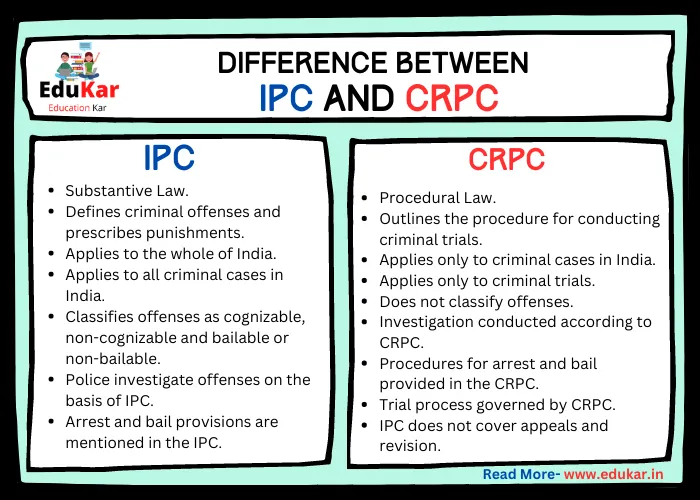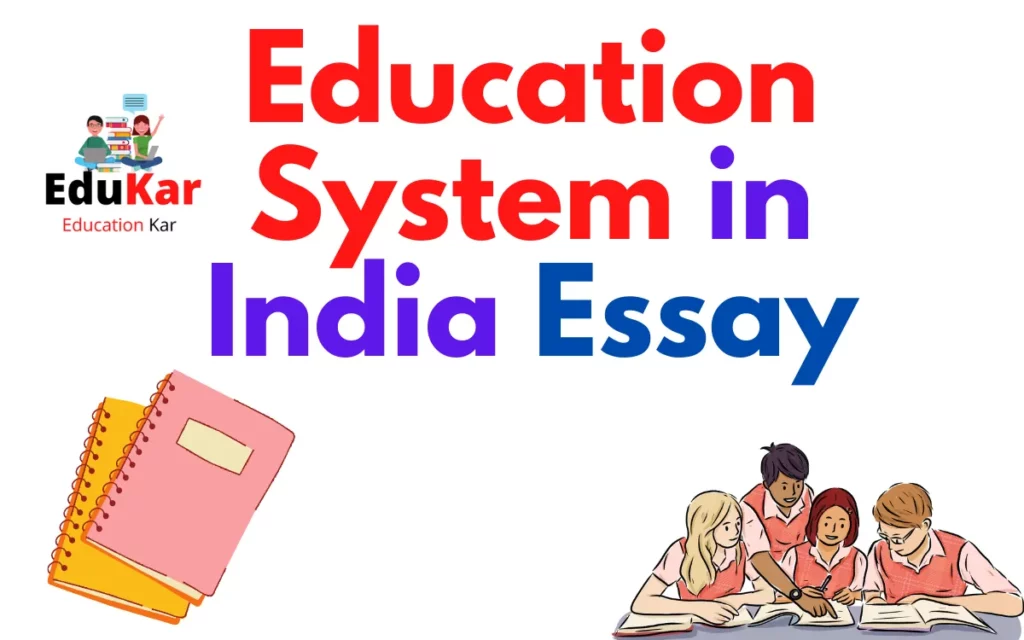Contents
- 1 Assignment A
- 2 Answer the following in about 500 words each.
- 3 1. Discuss the various stages in the policy process.
- 4 2. Examine the National Health Policy, 2017.
- 5 Assignment B
- 6 Answer the following questions in about 250 words each.
- 7 3. Describe the elite model of policy process.
- 8 4. Write a note on Citizen’s Charter.
- 9 5. Discuss the National Food Policy and highlight the measures accorded top priority in the policy.
- 10 Assignment C
- 11 Answer the following questions in about100 words each.
- 12 6. Highlight the critical observations of the Public Choice Model.
- 13 7. Discuss the significance of decentralisation.
- 14 8. Explain the significance of scrutiny of budget.
- 15 9. Enumerate the advantages and disadvantages of Zero-based budgeting.
- 16 10. Highlight the Family-centric Approach to social welfare.
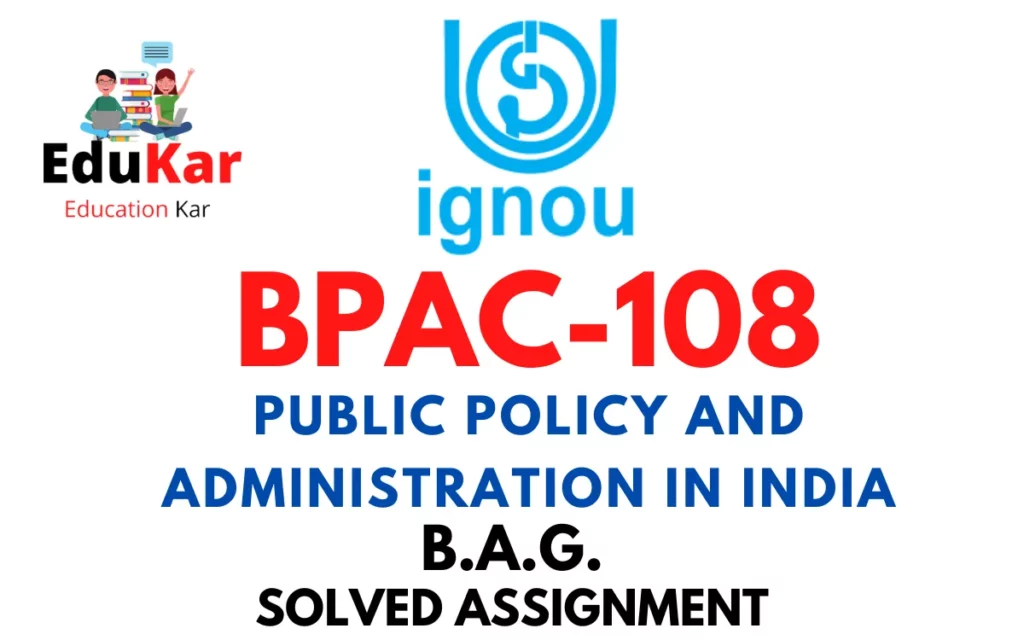
| Title | BPAC-108: IGNOU BAG Solved Assignment 2022-2023 |
| University | IGNOU |
| Degree | Bachelor Degree Programme |
| Course Code | BPAC-108 |
| Course Name | PUBLIC POLICY AND ADMINISTRATION IN INDIA |
| Programme Name | Bachelor of Arts (General) |
| Programme Code | BAG |
| Total Marks | 100 |
| Year | 2022-2023 |
| Language | English |
| Assignment Code | ASST/TMA/July 2022 & January 2023 |
| Assignment PDF | Click Here |
| Last Date for Submission of Assignment: | For June Examination: 31st April For December Examination: 30th September |
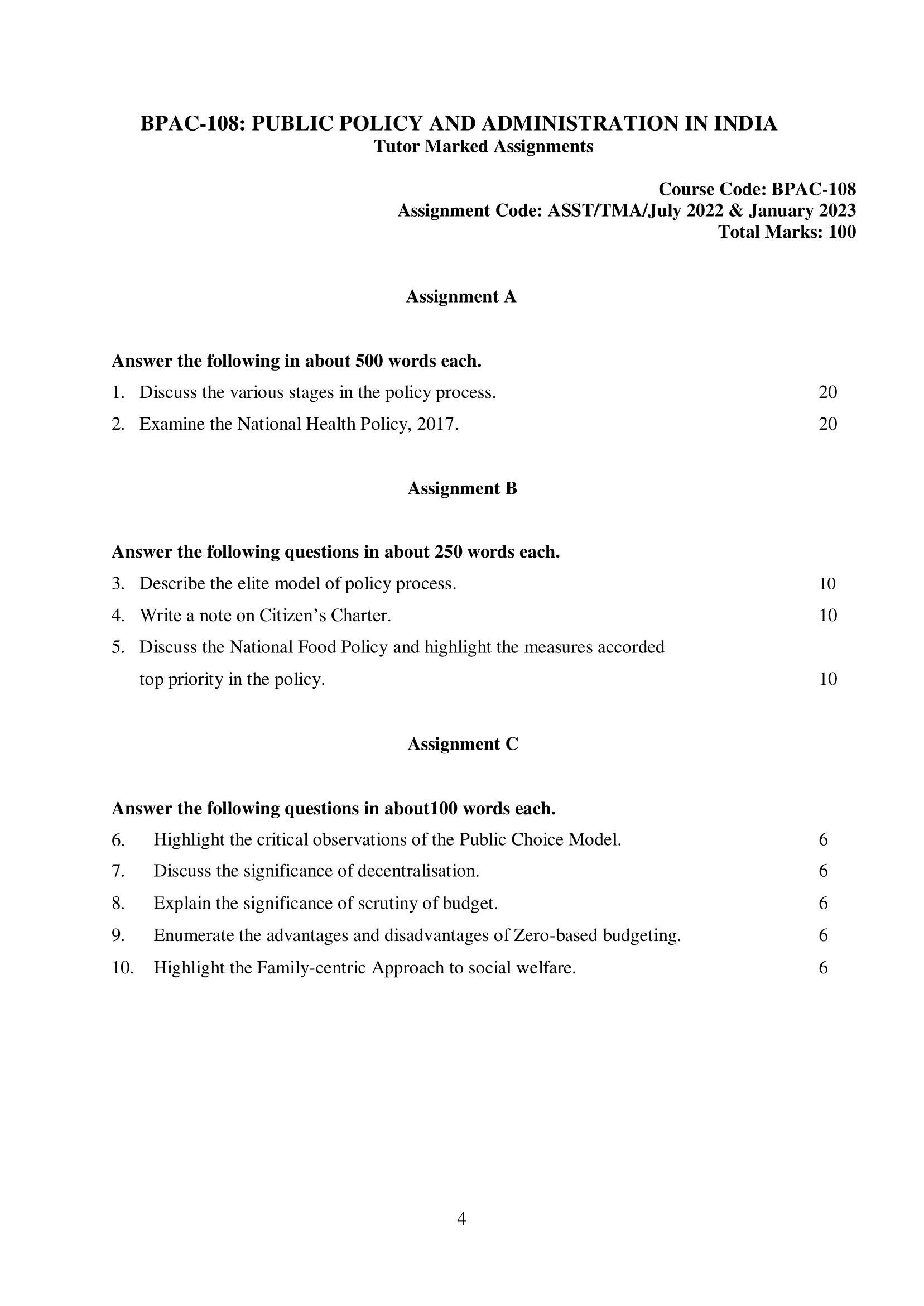
Assignment A
Answer the following in about 500 words each.
1. Discuss the various stages in the policy process.
Ans: The policy process is a series of stages that policymakers go through to identify, evaluate, and implement policy solutions to address specific issues or problems. The policy process is often cyclical and iterative, with each stage influencing the others. The following are the various stages of the policy process:
- Agenda Setting: Agenda setting is the first stage in the policy process. At this stage, policymakers identify problems that require attention and develop a list of potential policy solutions. Policymakers may identify issues through public opinion, media coverage, research reports, or interest groups. The importance of this stage cannot be overstated, as the issues that policymakers choose to address are often determined by what is on the agenda.
- Policy Formulation: Once the agenda is set, policymakers move to the policy formulation stage. At this stage, policymakers develop specific policy proposals to address the identified problems. This stage involves researching the problem, analyzing the available data, and considering the potential outcomes of various policy options. Policymakers may also consider the political feasibility of different policy solutions and the likely impact on various stakeholders.
- Adoption: After a policy proposal has been formulated, policymakers seek to obtain support for it from key stakeholders, including interest groups, the public, and other policymakers. Adoption may involve formal legislative action or executive action, depending on the specific policy issue and the political environment.
- Implementation: Once a policy is adopted, it must be implemented effectively. This stage involves the actual delivery of policy solutions and the allocation of resources necessary to make it happen. Policymakers may need to coordinate with various government agencies or private organizations to ensure that policies are effectively implemented.
- Evaluation: The final stage in the policy process is evaluation. At this stage, policymakers assess the effectiveness of the policy solution and its impact on the target problem. This stage involves monitoring and measuring the outcomes of the policy, determining whether it achieved its intended goals, and identifying any unintended consequences. Policymakers may use the evaluation results to make adjustments to the policy or to develop new policy solutions.
2. Examine the National Health Policy, 2017.
Ans: The National Health Policy (NHP) 2017 is a comprehensive document that lays down the vision, goals, and objectives for the health sector in India. The policy aims to provide universal access to quality healthcare services for all, with special focus on vulnerable sections of the society.
The key highlights of the NHP 2017 are as follows:
- Health and Wellness: The policy places a strong emphasis on promoting health and wellness by encouraging a healthy lifestyle, improving nutrition, and preventing illness through targeted interventions.
- Universal Health Coverage (UHC): The policy aims to provide affordable healthcare services to all citizens, including the marginalized and vulnerable sections of the society. It envisions that every individual should have access to a basic package of essential healthcare services.
- Strengthening the Public Health System: The NHP 2017 recognizes the need to strengthen the public health system by increasing public expenditure on healthcare, improving the quality of services, and promoting evidence-based decision making.
- Human Resources for Health (HRH): The policy emphasizes the need to address the shortage of skilled health workers in the country by increasing the number of health professionals, improving their training, and incentivizing them to work in rural and remote areas.
- Digital Health: The NHP 2017 recognizes the potential of digital technology to transform healthcare delivery in the country. It envisions the creation of a robust digital health infrastructure to enable the use of electronic health records, telemedicine, and mobile health services.
- Collaboration and Partnerships: The policy recognizes the importance of partnerships and collaboration between different stakeholders in the health sector, including the government, private sector, civil society, and international organizations.
- Financing: The NHP 2017 recognizes the need for increased public investment in healthcare and calls for innovative financing mechanisms to support the provision of affordable healthcare services.
Assignment B
Answer the following questions in about 250 words each.
3. Describe the elite model of policy process.
Ans: The elite model of policy process is a theoretical framework that proposes that the process of policymaking is dominated by a small, privileged group of individuals or organizations who hold significant power and influence. This group is commonly referred to as the “policy elite” or “power elite,” and they are often made up of business leaders, politicians, bureaucrats, and other influential members of society.
According to this model, the policy elite wield significant influence over the policy process through various means, including their access to resources, their ability to shape public opinion, and their ability to manipulate the political system. They are able to use their power and influence to advance their own interests and shape policy outcomes in a way that benefits them, rather than the broader public.
In the elite model, the general public is seen as largely passive and relatively powerless in the policymaking process. While they may have some influence through elections and other forms of political participation, they are often overshadowed by the power and influence of the policy elite. As a result, policy outcomes tend to reflect the interests and preferences of the elite, rather than the broader public.
Critics of the elite model argue that it is overly simplistic and does not fully capture the complexity of the policymaking process. They point out that there are many other factors that can influence policy outcomes, such as interest group activity, public opinion, and institutional constraints. However, the elite model continues to be a useful theoretical framework for understanding the role of power and influence in the policy process.
4. Write a note on Citizen’s Charter.
Ans: A Citizen’s Charter is a public statement of an organization’s commitments to its customers or citizens. It is a document that outlines the expectations, standards, and quality of service that an organization promises to deliver to its users or customers. The Citizen’s Charter was first introduced in the United Kingdom in the early 1990s, and since then, it has been widely adopted by many governments and public sector organizations around the world.
The main purpose of a Citizen’s Charter is to promote transparency, accountability, and good governance. By publishing a Citizen’s Charter, an organization is publicly committing to providing a certain level of service to its users, and this helps to build trust and confidence in the organization. The Charter also provides a mechanism for users to hold the organization accountable if it fails to deliver on its commitments.
A typical Citizen’s Charter will include information about the services provided by the organization, the standards of service that users can expect, and the mechanisms for providing feedback or making complaints. The Charter may also include information about the rights and responsibilities of users and the procedures for addressing grievances.
In many cases, the development of a Citizen’s Charter involves a consultative process with stakeholders and users of the organization’s services. This helps to ensure that the Charter reflects the needs and expectations of the users and is responsive to their concerns.
5. Discuss the National Food Policy and highlight the measures accorded top priority in the policy.
Ans: The National Food Policy is a comprehensive framework aimed at ensuring food security and promoting sustainable agriculture and rural development in a country. The policy is designed to address the complex and interconnected issues related to food production, distribution, and consumption, and to create a more equitable and sustainable food system.
The National Food Policy usually includes a range of measures to achieve its goals, and these measures are often given different levels of priority. Some of the measures that are usually accorded top priority in a National Food Policy include:
- Enhancing agricultural productivity: One of the top priorities in a National Food Policy is to increase agricultural productivity by providing farmers with better access to inputs, such as seeds, fertilizers, and machinery. This can be achieved through a range of measures, including subsidies, credit facilities, and technical assistance.
- Improving food distribution: Another key priority in a National Food Policy is to improve food distribution systems, particularly in rural areas. This can be done by investing in infrastructure, such as roads and storage facilities, and by developing more efficient and effective supply chains.
- Promoting food safety and quality: Ensuring that food is safe and of good quality is a top priority in a National Food Policy. This can be achieved through measures such as food safety regulations, quality control systems, and consumer education campaigns.
- Addressing malnutrition: Another important priority in a National Food Policy is to address malnutrition, particularly in vulnerable populations such as children and pregnant women. This can be done through measures such as food fortification, nutrition education programs, and social safety nets.
- Promoting sustainable agriculture: Ensuring that agriculture is sustainable and environmentally friendly is a key priority in a National Food Policy. This can be achieved through measures such as promoting organic farming, reducing the use of pesticides and fertilizers, and supporting agroforestry and other sustainable farming practices.
Assignment C
Answer the following questions in about100 words each.
6. Highlight the critical observations of the Public Choice Model.
Ans: The Public Choice Model is a theoretical framework that applies the principles of economics to the analysis of political behavior and decision-making. Some of the critical observations of the Public Choice Model include:
- Self-interest: The Public Choice Model assumes that individuals act in their own self-interest, and that this behavior extends to the political realm. This means that politicians and public officials may be motivated by personal gain rather than the public interest.
- Rationality: The Public Choice Model assumes that individuals are rational and make decisions based on a cost-benefit analysis. This means that politicians and public officials may make decisions that benefit them or their constituents, even if it is not in the overall public interest.
- Rent-seeking: The Public Choice Model highlights the role of rent-seeking, which refers to the use of political power to gain economic advantages. This means that politicians and public officials may support policies that benefit a particular group or industry in exchange for political support or financial contributions.
- Interest groups: The Public Choice Model acknowledges the role of interest groups in the political process. These groups may lobby politicians and public officials in order to influence policy outcomes in their favor.
7. Discuss the significance of decentralisation.
Ans: Decentralization is the process of transferring power and decision-making from a central authority to local or regional levels of government, organizations, or communities. The main goal of decentralization is to empower local actors to make decisions that are more responsive to the needs and priorities of their communities. There are several significant advantages of decentralization:
- Improved efficiency: Decentralization can improve the efficiency of public service delivery by bringing decision-making closer to the point of service delivery. This can lead to faster and more effective decision-making, better use of resources, and greater responsiveness to local needs.
- Better governance: Decentralization can promote better governance by increasing transparency, accountability, and citizen participation in decision-making. This can help to reduce corruption and improve the quality of public services.
- Enhanced local development: Decentralization can facilitate local development by empowering local actors to identify and prioritize local needs and opportunities. This can lead to more effective use of local resources, increased investment, and greater economic growth.
- Strengthened democracy: Decentralization can strengthen democracy by promoting greater citizen participation in decision-making and promoting the values of transparency and accountability. This can help to build stronger democratic institutions and foster greater trust between citizens and their government.
- Reduced conflict: Decentralization can reduce conflict by giving local actors greater control over their own affairs and reducing the potential for central government intervention in local disputes.
8. Explain the significance of scrutiny of budget.
Ans: Scrutiny of budget is an essential process that involves a detailed review and evaluation of a company’s or government’s financial plan. It is crucial to ensure that the resources allocated to different programs or projects are utilized efficiently and effectively. The scrutiny of budget helps in identifying any potential areas of overspending or underspending, which can lead to financial instability.
The scrutiny of budget also helps in setting priorities and making informed decisions about where to allocate resources. It ensures that there is a fair distribution of resources and that no program or project is neglected. Additionally, it helps to identify any discrepancies in financial reporting and provides a basis for corrective action to be taken.
Furthermore, scrutiny of budget is significant in ensuring accountability and transparency in financial management. By analyzing and reporting the budget, stakeholders can evaluate the performance of the organization and ensure that funds are used in accordance with established policies and regulations. Overall, the scrutiny of budget is essential for financial stability, proper resource allocation, and transparency in financial management.
9. Enumerate the advantages and disadvantages of Zero-based budgeting.
Ans: Zero-based budgeting (ZBB) is a budgeting technique that requires every budget item to be justified and evaluated from scratch, rather than simply relying on last year’s budget figures. Here are some advantages and disadvantages of ZBB:
Advantages:
- Encourages cost control: ZBB requires each budget item to be justified, leading to better control over costs.
- Promotes efficiency: By examining each budget item in detail, ZBB can help identify wasteful spending and promote greater efficiency.
- Aligns resources with priorities: ZBB helps to ensure that resources are allocated in accordance with the organization’s priorities and objectives.
- Supports innovation: ZBB can encourage innovative thinking and lead to new ideas for resource allocation.
- Increases accountability: ZBB can promote greater accountability in budgeting and financial management.
Disadvantages:
- Time-consuming: ZBB requires a significant amount of time and effort to evaluate each budget item.
- Requires specialized expertise: ZBB may require specialized expertise, which may be difficult to obtain.
- May not be suitable for all organizations: ZBB may not be suitable for small organizations with limited resources.
- Can be too rigid: ZBB can be too rigid and inflexible, making it difficult to respond to unforeseen circumstances.
- Can lead to budget cuts: ZBB can lead to budget cuts, which may negatively impact some programs or services.
Ans: The family-centric approach to social welfare is based on the idea that families are the basic unit of society and that the well-being of individuals is closely linked to the well-being of their families. This approach emphasizes the importance of providing social support and services to families as a whole, rather than just to individual members.
The family-centric approach recognizes that families have diverse needs and that interventions should be tailored to address these needs. This approach involves working with families to identify their strengths and challenges and providing them with the resources and support they need to overcome obstacles and build resilience.
Some examples of family-centric interventions include family counseling, parenting education, and family therapy. By focusing on the family as a whole, rather than just individual members, the family-centric approach to social welfare aims to promote the overall well-being and functioning of families, and ultimately, of society as a whole.
How to Download BPAC-108 Solved Assignment?
You can download it from the www.edukar.in, they have a big database for all the IGNOU solved assignments.
Is the BPAC-108 Solved Assignment Free?
Yes this is absolutely free to download the solved assignment from www.edukar.in
What is the last submission date for BPAC-108 Solved Assignment?
For June Examination: 31st April, For December Examination: 30th October


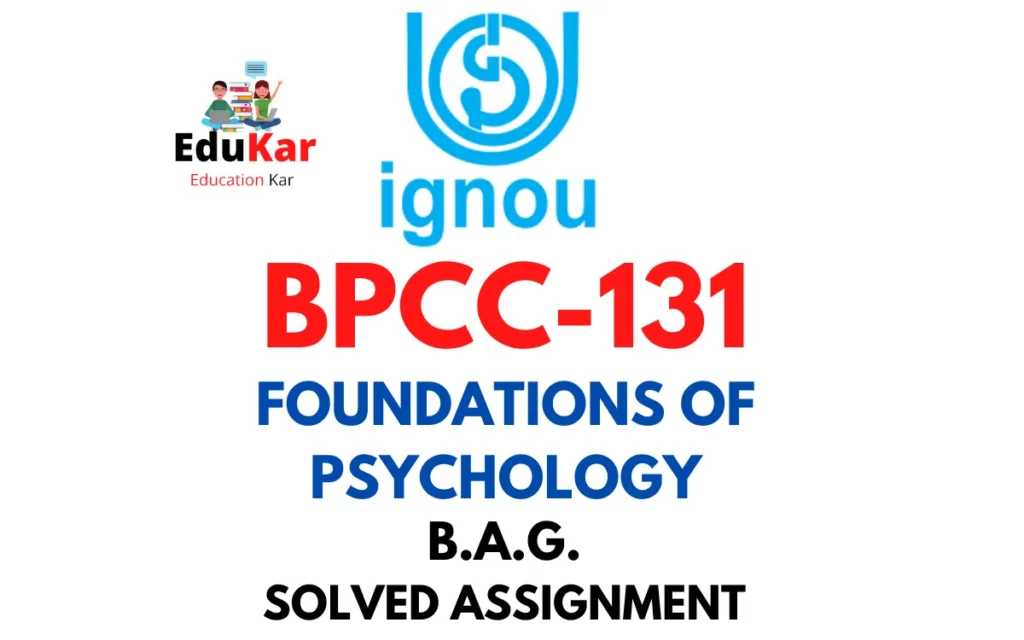
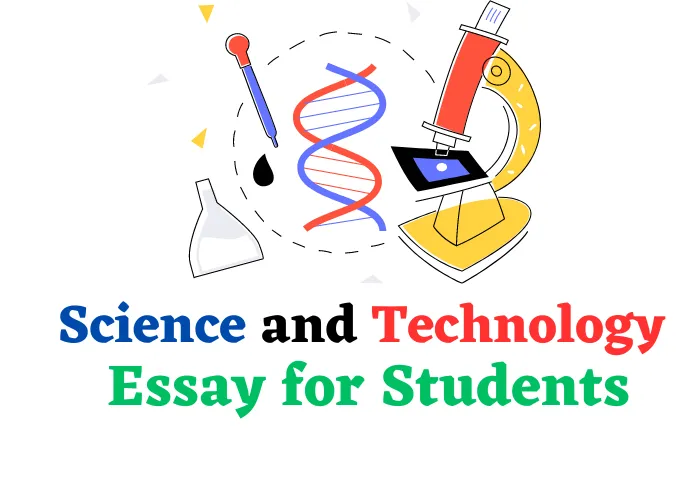
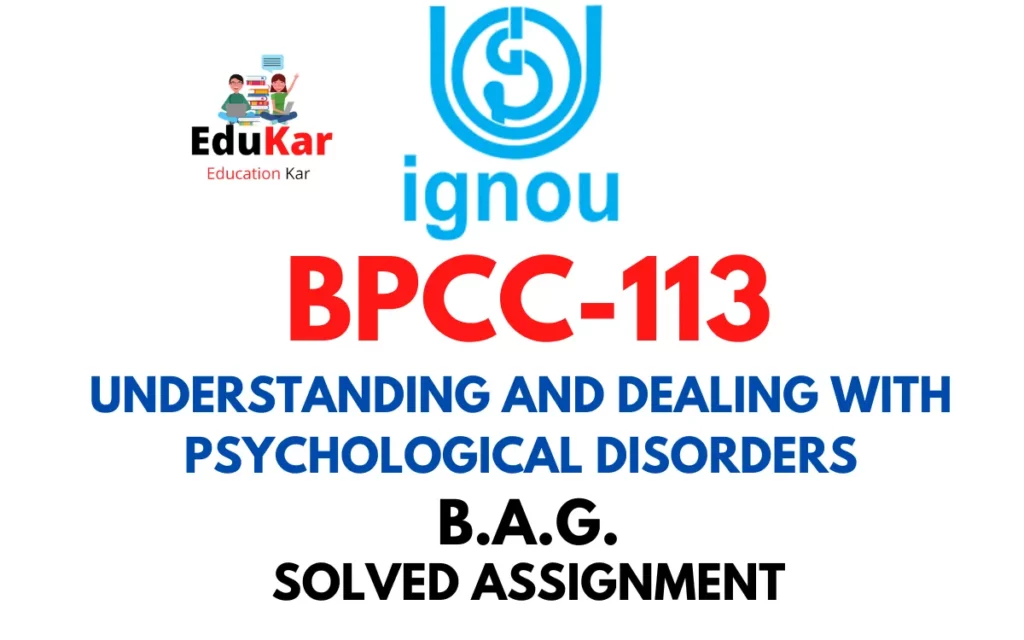

![Best 5 Speech on Yoga [Long & Short] Speech-on-Yoga](https://edukar.in/wp-content/uploads/2023/03/Speech-on-Yoga.webp)
![Speech on Subhash Chandra Bose [Short & Long] Speech-on-Subhash-Chandra-Bose](https://edukar.in/wp-content/uploads/2023/03/Speech-on-Subhash-Chandra-Bose.webp)
